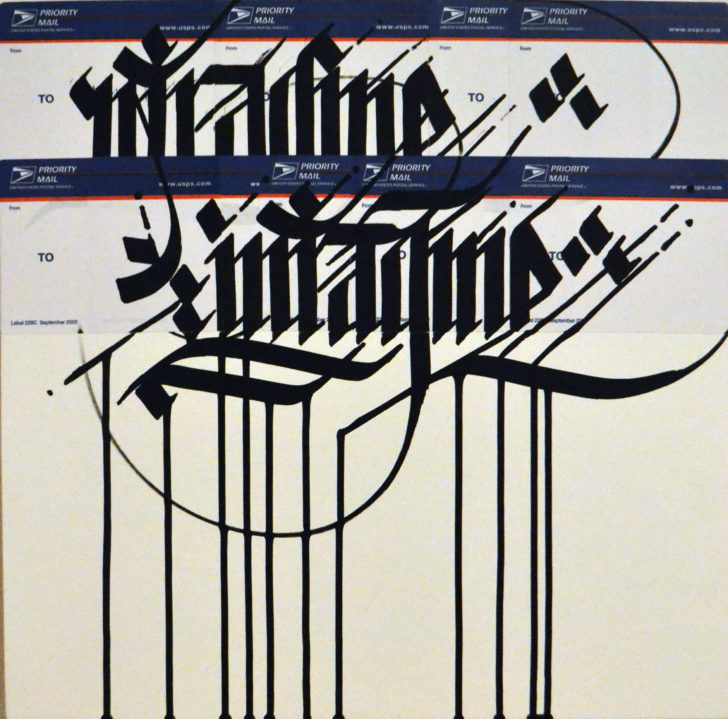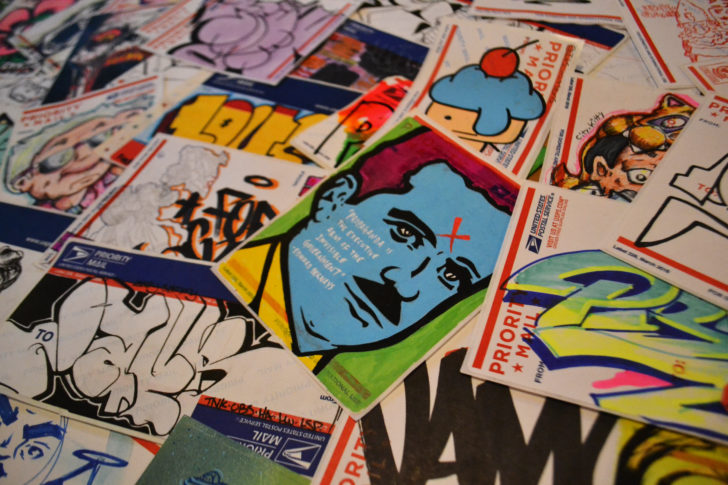
The graffiti writer’s love for Priority Mail 228 labels is that which a locavore has for a fresh bunch of backyard arugula. Much like the way a gardener looks at a field and savors the wonder of crops growing from dirt and water, artists for generations have walked into US mailrooms without any money and exited with their pockets full of street supplies. From there, they manufactured glorious tagsake decals to affix the world over, aggravating anti-graf stiffs every stick of the way.
Now that we are decades into this tradition and have become accustomed to seeing said labels on bus shelters and street signs that we rely on as reference points in calibrating our place in the world, it is only right that intersections of graffiti and illicit sticker art meet in proper display spaces and galleries. To that end, the medium was highlighted in Mass five years ago with a show in New Bedford at the UGLYgallery, while more recently exhibits have opened in places as far away as Arizona (Going Postal) and Switzerland (Slap Me Baby).
Back in Boston, starting this week at the Dorchester Art Project (with an opening reception Jan 5), heads will have a month to view this kind of literally outside-of-the-box work from more than a hundred artists hailing from across the country plus the UK and Canada (big names include Tense, Imagine876, Deme5, Soems, Take1, Rob Stull, Omega Rocks, and Jayel 228 from New York, among others). We spoke with show producer Jacob Leidolf of Scope Apparel about the event, co-organized by AoA Supply, the Pen & Sword Political Pirates collective, and Voices of Liberation.

What exactly is it about USPS labels that make for such a remarkable surface?
Probably the most striking thing about 228s is how widespread their use is by artists due in large part to their availability. Literally any place in this country that is considered a “place” is so partially in definition because it has at least one post office of its own. That’s what makes it a city or a town or whatever. And any post office can be a source of free art supplies. Sure, folks also gravitate to other free or common labels and stickers (UPS, FedEx, Hello My Name Is, etc.) but the sheer ubiquity of post offices and the labels within definitely contributes to their wide usage among artists.
As a phenomenon within graffiti and street art culture, artists build on one another’s developments and experiments, trying to one-up or outdo your peers, making the sticker something of a battleground just like a wall or a page. Some cats use them as a surface that can be worked for a really long time in the comfort of one’s space but deployed out in the world relatively quickly; others use the sticker for the sheer volume, making and placing as many “slaps” as they can.
There is also the trading and collaborative aspect, where artists seek work out and use the stickers as the common surface that anyone can make their own. Some are collectors, some trade and post stickers, allowing artists to operate outside their immediate area. As more and more people use them, they become a traditional marquee in the same way walls or canvases or freight trains feel like home to some artists.
There is also the graphic and design aspects of the label, which different artists use differently, covering over or preserving the blue fields, red stripes, and postal logos as part of their design and composition choices. The first Label 228s came out in 1991 and have changed every few years, resulting in a wide array of sizes and variations, some of which are extremely rare and collectible to some cats. Twenty-eight years later, there are deep and diverse traditions among many sets of artists who have adopted the postal sticker as a canvas. This show tries to tell some of that story.
Are there any that you or a friend threw up years ago that you still see out in the wild and can’t believe that it’s still there?
I have watched many slaps go through their lifetime on streets or corners I pass regularly going from bold and bright to faded fragments. All creations are temporary and transient. I think graffiti artists just embrace and confront that reality more directly in their work. But there are all kinds of ways to fight that clock—from covering stickers with packing tape or vinyl to placing them in sheltered spots. But at the end of the day it is not an acid-free archival medium, and even without being exposed to the elements a sticker will change over time.
Are there any urban legends around the labels that you’ve heard in your time around writers? Like that it’s a felony to use federal property in such a fashion, or something like that?
Never heard of anyone getting in trouble for using them to draw on, maybe for placing them out in the world. There are warnings about misusing federal property, but believe it or not, the rampant abuse those warnings are meant to curb comes from people using Priority Mail materials to send packages not as Priority Mail, thus not paying the rate that is supposed to cover the cost of those “free” materials. They seem to have more trouble from people turning boxes inside out and cutting up labels for their own personal stationary than they do from writers. Especially since what a lot of cats seek out is old and discontinued models. There are some legendary stories about how some cats acquired vast numbers of blank stickers and commercial-only versions.

In your experience, are certain post offices that get hit up for their labels more than others in the habit of keeping them behind the counter instead of leaving them out in the open?
It depends. They all have to keep a certain amount out and available. But how many and how often that pile gets depleted or replenished could have something to do with your friendly neighborhood artist.
Has the quality of USPS labels changed over the years? For better or for worse?
We were just talking about this the other day when we were setting up the show. The early models are highly prized partly because they’re rare and visually distinct, partially because they’re larger labels to work on. The 2002 was loved for its large white background. Later models featured a watermark which was not actually meant to deter art but people cutting off the “Priority” topper and using the stickers as To/From labels. The watermark lasted until the most recent version, the 2016, which is well liked for its large white space to work on. Everyone has their own favorites, but a lot of folks cherish the old blue tops that were around in the ’90s and ’00s.
Where did the idea for the show come from?
There have been shows like this all over for years. This year there were several around the US and overseas. The first one I participated in was at the UGLYgallery in New Bedford, but I had wanted to do one [in Boston] for some time now, and after reconnecting with the AOA Supply fam around their BlackBook Sessions over the last couple years, it was easy to find other folks who were interested and willing to help organize and plan it. There is a deep community of artists around this, so part of the goal of the show is to bring everyone together since we often are working in parallel. When Dorchester Art Project jumped on board to host it, we were able to start moving on it for real.
There’s a pretty remarkable array of artists. How did you select the lineup? It seems like this is the kind of thing that every writer in New England would want to be a part of if they heard about it.
We put out an open call and just have been hitting the pavement, word of mouth, and online to reach out to folks. We were overwhelmed by the reception and the biggest challenge is going through all the incredible work. So far everyone has been really supportive and excited, it’s just a matter of following up and making sure to reach out and include folks. Shout-out to everyone who submitted work and everyone who helped recruit artists to submit—it was a tremendous team effort and we’re looking forward to what is hopefully the first of many sticker shows. Anyone who missed the deadline, hit us up, it’s only the beginning!
Any more words on what heads can expect?
For the opening we have live music by Grubby Pawz, Loman, SPNDA and Eboane AUD. We’re having DJ Bobby Bangers come through for the closing. AOA Supply will be hosting Blackbook Sessions, where people can come draw together both nights and during some of the gallery days. We’re really hoping to make the show interactive and have the project continue to grow and develop as a way to document the work of artists in Boston and beyond, and to bring folks together to share their love of art and stickers.
PRIORITY MADE. 1.5–2.9 AT DORCHESTER ART PROJECT, 1486 DORCHESTER AVE., BOSTON. OPENING RECEPTION 1.5, 6-10PM. CLOSING RECEPTION 2.9, 6-10PM.
This piece was first published at digboston on 01/02/19 and is being re-posted here with the express permission of that fine publication.

